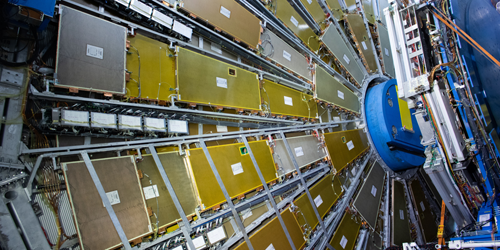Addressing WWW Production in Particle Collisions
The World Wide Web was invented at CERN in 1989 as a way to share data from particle-physics experiments. Now one of those experiments, ATLAS, is sharing data that carries the label “WWW” for a different reason. Sifting through 20 billion proton-proton collisions from Run 2 at CERN’s Large Hadron Collider (LHC), the ATLAS team has identified around 270 events producing three W bosons [1]. By measuring these rare events, the researchers have provided another high-precision test of the standard model of particle physics—in particular, regarding boson-boson interactions.
In the standard model, bosons carry the fundamental forces: for example, W and Z bosons carry the weak force, while photons carry the electromagnetic force. The new measurements are not the first in which three weak-force bosons have been spotted in particle collisions (see Synopsis: Hat Trick Observation for Bosons). However, this is the first time that observers have pinpointed that the bosons are W’s, rather than a mixture of W’s and Z’s. By extracting W-only events, the ATLAS team was able to target specific interactions, including ones where a single W decays into three lower-energy W’s. These interactions could potentially be sensitive to hypothetical particles that aren’t predicted in the standard model.
At collision energies of 13 TeV, the ATLAS team measured the WWW cross section (a measure of the probability of this event) to be 820 femtobarns, which is slightly higher than the standard model prediction. To tell whether this overproduction is real or just a statistical fluke, researchers will need more data, which is likely to come from the recently started LHC Run 3 (see Research News: Good Omens for Run 3).
–Michael Schirber
Michael Schirber is a Corresponding Editor for Physics Magazine based in Lyon, France.
References
- G. Aad et al. (ATLAS Collaboration), “Observation of WWW production in pp collisions at √s=13TeV with the ATLAS detector,” Phys. Rev. Lett. 129, 061803 (2022).




